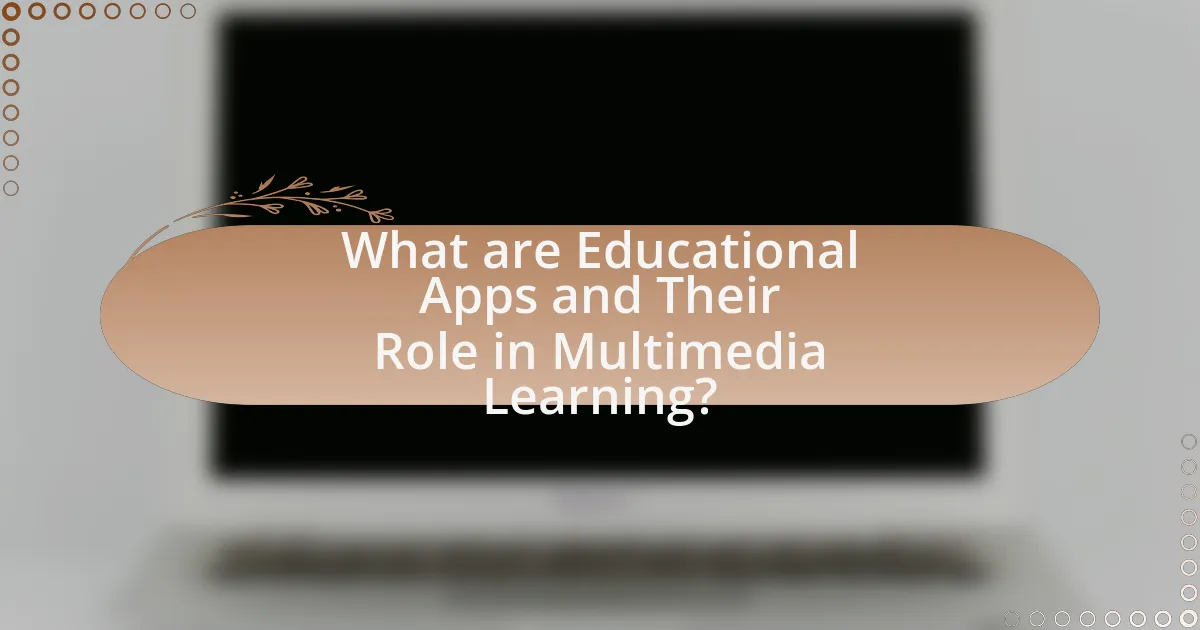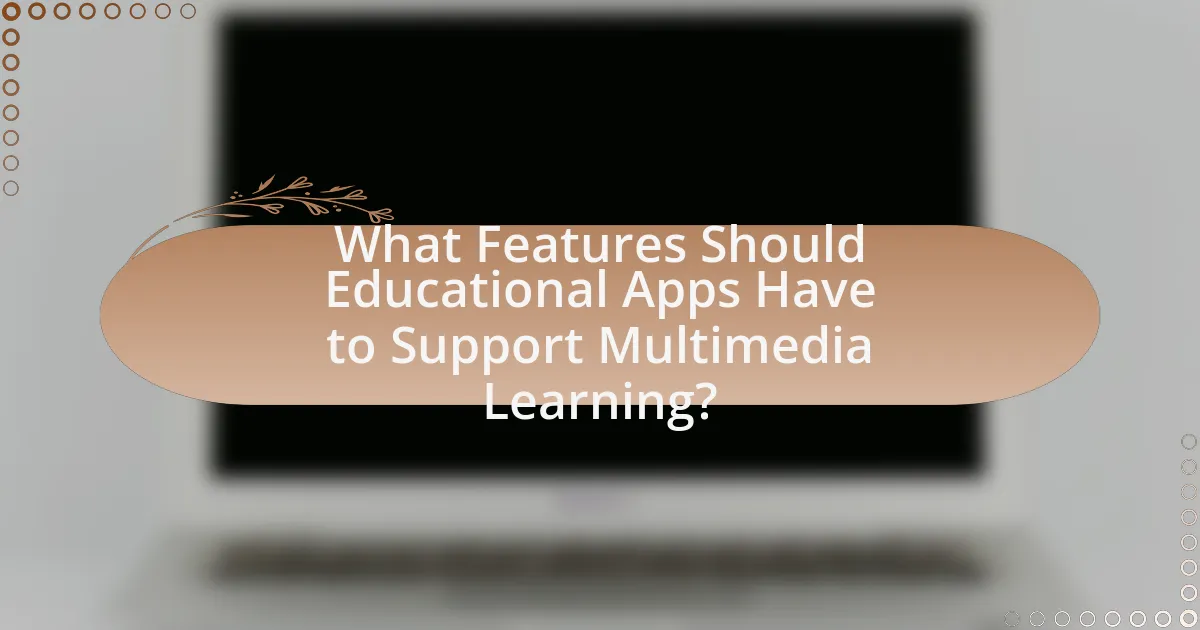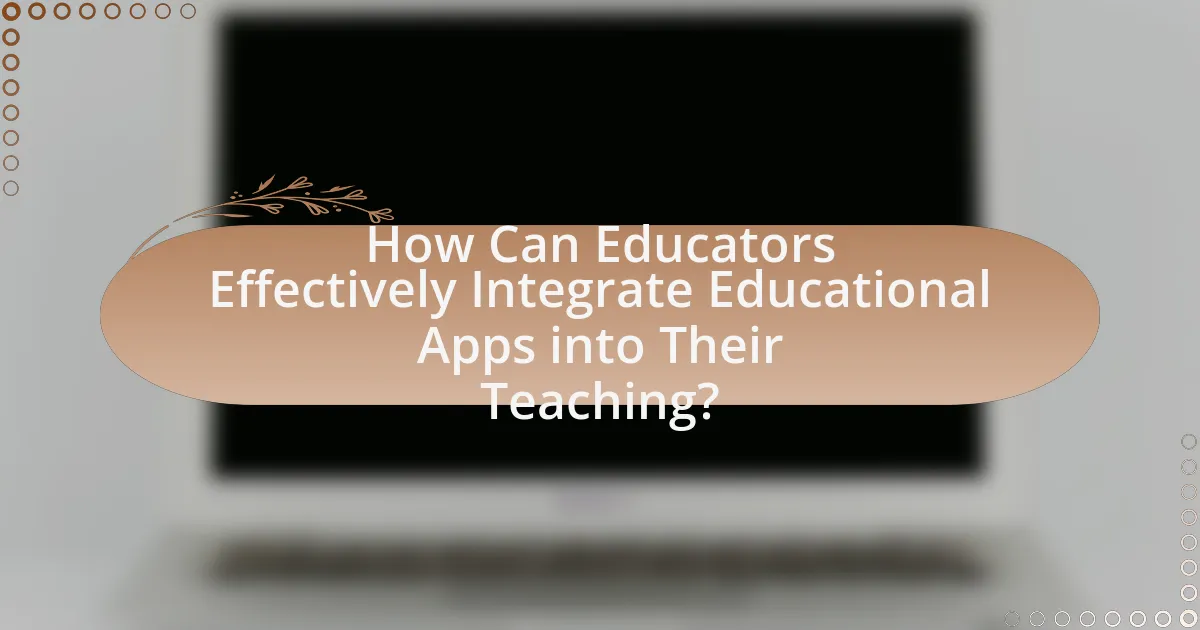Educational apps are software applications designed to enhance learning through interactive and engaging multimedia content, integrating text, audio, images, and video. These apps significantly improve multimedia learning by catering to diverse learning styles, leading to better retention and understanding of information. The article explores how educational apps enhance multimedia learning experiences, the types of multimedia content they include, and the cognitive benefits they provide. It also discusses the importance of user interface design, accessibility features, and interactive elements in maximizing educational outcomes, as well as strategies for educators to effectively integrate these apps into their teaching practices.

What are Educational Apps and Their Role in Multimedia Learning?
Educational apps are software applications designed to facilitate learning through interactive and engaging content. These apps play a crucial role in multimedia learning by integrating various forms of media, such as text, audio, images, and video, to enhance the educational experience. Research indicates that multimedia learning can improve retention and understanding; for instance, the Cognitive Theory of Multimedia Learning, proposed by Richard Mayer, suggests that people learn better from words and pictures than from words alone. This theory is supported by studies showing that educational apps utilizing multimedia elements can lead to higher engagement and improved learning outcomes among users.
How do educational apps enhance multimedia learning experiences?
Educational apps enhance multimedia learning experiences by integrating various forms of content, such as text, audio, video, and interactive elements, into a cohesive learning environment. This integration allows learners to engage with material in multiple ways, catering to different learning styles and preferences. For instance, a study published in the Journal of Educational Psychology found that students using multimedia resources performed better on assessments compared to those using traditional methods, demonstrating the effectiveness of diverse content formats in improving comprehension and retention.
What types of multimedia content do educational apps typically include?
Educational apps typically include various types of multimedia content such as videos, interactive quizzes, audio recordings, animations, and images. These elements enhance the learning experience by catering to different learning styles and making complex concepts more accessible. For instance, videos can demonstrate processes visually, while interactive quizzes provide immediate feedback, reinforcing knowledge retention. Research indicates that multimedia learning can improve engagement and understanding, as evidenced by studies showing that students using multimedia resources perform better in assessments compared to those relying solely on text-based materials.
How do educational apps cater to different learning styles?
Educational apps cater to different learning styles by incorporating various multimedia elements such as visual aids, auditory instructions, and interactive activities. For instance, apps designed for visual learners often include diagrams, videos, and infographics, while those targeting auditory learners may feature podcasts, narrated lessons, and sound effects. Kinesthetic learners benefit from interactive simulations and hands-on activities that allow them to engage physically with the content. Research indicates that utilizing multiple modalities can enhance retention and understanding, as supported by studies showing that learners who engage with content through their preferred style perform better academically.
Why is multimedia learning important in education?
Multimedia learning is important in education because it enhances understanding and retention of information through the integration of various formats such as text, audio, images, and video. Research indicates that students who engage with multimedia resources demonstrate improved learning outcomes, as evidenced by a study published in the Journal of Educational Psychology, which found that multimedia presentations can increase retention rates by up to 50% compared to traditional methods. This effectiveness is attributed to the dual coding theory, which posits that information is better processed when presented in both verbal and visual formats, thereby facilitating deeper cognitive processing and engagement.
What cognitive benefits does multimedia learning provide?
Multimedia learning enhances cognitive benefits such as improved retention, better understanding of complex concepts, and increased engagement. Research indicates that combining visual and auditory information can lead to deeper processing, which enhances memory retention. For instance, the Cognitive Theory of Multimedia Learning, proposed by Richard Mayer, suggests that people learn better from words and pictures than from words alone, as evidenced by studies showing that students who engage with multimedia resources score higher on retention tests compared to those who use traditional text-based materials.
How does multimedia learning improve student engagement?
Multimedia learning improves student engagement by integrating various forms of content, such as text, audio, images, and video, which caters to different learning styles and keeps students actively involved. Research indicates that students who engage with multimedia resources demonstrate higher retention rates and motivation compared to traditional learning methods. For instance, a study published in the Journal of Educational Psychology found that students using multimedia tools scored 20% higher on retention tests than those relying solely on text-based materials. This enhanced engagement is attributed to the interactive nature of multimedia, which encourages exploration and participation, leading to a more immersive learning experience.

What Features Should Educational Apps Have to Support Multimedia Learning?
Educational apps should have interactive content, multimedia integration, and adaptive learning features to effectively support multimedia learning. Interactive content, such as quizzes and simulations, engages learners and enhances retention by allowing them to actively participate in the learning process. Multimedia integration, which includes videos, audio, and animations, caters to different learning styles and helps clarify complex concepts. Adaptive learning features personalize the educational experience by adjusting the difficulty level and content based on individual learner performance, ensuring that each user receives tailored support. These features are supported by research indicating that interactive and multimedia-rich environments significantly improve learning outcomes, as demonstrated in studies published in the Journal of Educational Psychology.
How do user interface and design impact the effectiveness of educational apps?
User interface and design significantly impact the effectiveness of educational apps by influencing user engagement, comprehension, and retention of information. A well-designed interface enhances usability, making it easier for learners to navigate and interact with content, which is crucial for maintaining attention and motivation. Research indicates that apps with intuitive layouts and visually appealing elements can lead to a 30% increase in user satisfaction and a 25% improvement in learning outcomes, as users are more likely to engage with content that is presented in an accessible and attractive manner. Furthermore, effective design elements, such as clear typography and appropriate color schemes, can facilitate better information processing, thereby enhancing cognitive load management and supporting multimedia learning principles.
What design principles enhance user experience in educational apps?
User experience in educational apps is enhanced by principles such as simplicity, consistency, feedback, and accessibility. Simplicity ensures that users can navigate the app easily, reducing cognitive load and allowing for focused learning. Consistency across design elements helps users develop familiarity with the interface, which can improve retention and usability. Providing timely feedback reinforces learning by confirming correct actions or guiding users when they make mistakes. Accessibility ensures that all users, including those with disabilities, can effectively engage with the app, broadening its reach and impact. These principles are supported by research indicating that user-centered design significantly improves engagement and learning outcomes in educational technology.
How can accessibility features improve multimedia learning for all students?
Accessibility features enhance multimedia learning for all students by providing tailored support that accommodates diverse learning needs. These features, such as text-to-speech, closed captioning, and adjustable text sizes, ensure that students with disabilities can engage with content effectively. Research indicates that inclusive design not only benefits students with disabilities but also improves overall learning experiences for all learners by promoting engagement and comprehension. For instance, a study published in the “Journal of Educational Psychology” found that students using multimedia resources with accessibility features demonstrated higher retention rates and improved understanding of the material compared to those without such features. This evidence underscores the importance of integrating accessibility into educational apps to foster an inclusive learning environment.
What types of interactive elements are beneficial in educational apps?
Interactive elements that are beneficial in educational apps include quizzes, drag-and-drop activities, simulations, and gamified learning experiences. Quizzes provide immediate feedback, enhancing retention and understanding, while drag-and-drop activities engage users in hands-on learning, promoting active participation. Simulations allow learners to explore complex concepts in a controlled environment, facilitating experiential learning. Gamified experiences, which incorporate game mechanics into educational content, have been shown to increase motivation and engagement, as evidenced by studies indicating that gamification can improve learning outcomes by up to 50%. These interactive elements collectively foster a more engaging and effective learning experience in educational apps.
How do quizzes and assessments enhance learning outcomes?
Quizzes and assessments enhance learning outcomes by providing immediate feedback, reinforcing knowledge retention, and identifying areas for improvement. Immediate feedback allows learners to understand their mistakes and correct misconceptions, which is crucial for effective learning. Research indicates that students who engage in frequent assessments demonstrate higher retention rates; for instance, a study published in the journal “Psychological Science” found that retrieval practice, such as quizzes, significantly boosts long-term retention of information. Additionally, assessments help educators tailor instruction to meet individual student needs, ensuring that learning is personalized and effective.
What role do gamification elements play in educational apps?
Gamification elements in educational apps enhance user engagement and motivation by incorporating game-like features such as points, badges, and leaderboards. These elements create a competitive and rewarding environment that encourages learners to participate actively and persist in their studies. Research indicates that gamification can lead to improved learning outcomes; for instance, a study published in the Journal of Educational Psychology found that students using gamified learning platforms showed a 20% increase in retention rates compared to traditional methods. This demonstrates that gamification effectively supports multimedia learning by making educational experiences more interactive and enjoyable.

How Can Educators Effectively Integrate Educational Apps into Their Teaching?
Educators can effectively integrate educational apps into their teaching by aligning app functionalities with learning objectives and actively engaging students in the learning process. This approach ensures that the selected apps serve specific educational purposes, such as enhancing understanding of complex concepts or facilitating collaborative learning. Research indicates that when educators utilize apps that complement their curriculum, student engagement and achievement improve; for instance, a study published in the “Journal of Educational Technology & Society” found that 78% of teachers reported increased student motivation when using educational apps. Additionally, providing training for both educators and students on how to use these apps maximizes their potential, as demonstrated by a 2019 report from the International Society for Technology in Education, which highlighted that professional development significantly enhances the effective use of technology in classrooms.
What strategies can educators use to select the right educational apps?
Educators can select the right educational apps by evaluating their alignment with curriculum standards, assessing user reviews and ratings, and ensuring the app’s usability and accessibility. Aligning apps with curriculum standards guarantees that the content meets educational goals, while user reviews provide insights into the app’s effectiveness and user experience. Additionally, usability ensures that both educators and students can navigate the app easily, and accessibility ensures that all students, including those with disabilities, can benefit from the app. Research indicates that apps that are user-friendly and aligned with educational standards significantly enhance learning outcomes, making these strategies essential for effective app selection.
How can educators assess the quality and effectiveness of educational apps?
Educators can assess the quality and effectiveness of educational apps by evaluating their alignment with learning objectives, user engagement, and evidence of learning outcomes. Specifically, educators should examine whether the app’s content meets curriculum standards and promotes critical thinking skills. Research indicates that apps designed with clear educational goals and interactive features enhance student engagement and retention (Hwang & Chang, 2011). Additionally, educators can analyze user feedback and performance data to determine the app’s impact on student learning, as studies show that apps with positive user reviews correlate with higher educational effectiveness (Kirkpatrick & Kirkpatrick, 2006).
What criteria should be considered when choosing apps for specific subjects?
When choosing apps for specific subjects, consider educational alignment, user engagement, accessibility, and feedback mechanisms. Educational alignment ensures that the app’s content matches curriculum standards and learning objectives, which is crucial for effective learning outcomes. User engagement is important as interactive and visually appealing apps can enhance motivation and retention of information. Accessibility ensures that the app is usable for all learners, including those with disabilities, which is vital for inclusive education. Feedback mechanisms, such as quizzes or progress tracking, provide learners with insights into their understanding and areas for improvement, reinforcing the learning process.
How can educators encourage student engagement with educational apps?
Educators can encourage student engagement with educational apps by integrating interactive features and gamification elements into the learning experience. Research shows that apps incorporating game-like elements, such as rewards and challenges, significantly increase student motivation and participation. For instance, a study published in the Journal of Educational Psychology found that students using gamified learning apps demonstrated a 34% increase in engagement compared to traditional methods. Additionally, providing opportunities for collaboration through shared tasks within the app fosters a sense of community and enhances engagement, as students are more likely to participate when they can work together towards common goals.
What methods can be used to incorporate educational apps into lesson plans?
Educational apps can be incorporated into lesson plans through methods such as aligning app content with curriculum standards, using apps for interactive assessments, and integrating collaborative features for group projects. Aligning app content ensures that the educational objectives are met, as apps often provide resources that complement traditional teaching materials. For example, using a math app that aligns with state standards allows students to practice skills relevant to their grade level. Interactive assessments through apps can provide immediate feedback, enhancing the learning experience by allowing teachers to adjust instruction based on real-time data. Additionally, apps that facilitate collaboration, such as shared document editing or discussion forums, encourage teamwork and communication among students, which are essential skills in modern education. These methods not only enhance engagement but also support diverse learning styles, making lessons more effective.
How can feedback and support enhance the use of educational apps in the classroom?
Feedback and support enhance the use of educational apps in the classroom by providing students with guidance and motivation, which leads to improved learning outcomes. When educators offer timely and constructive feedback on app usage, students can identify areas for improvement and adjust their learning strategies accordingly. Research indicates that students who receive regular feedback demonstrate higher engagement and retention rates, as evidenced by a study published in the Journal of Educational Psychology, which found that feedback significantly boosts student performance in technology-enhanced learning environments. Additionally, support from teachers and peers fosters a collaborative learning atmosphere, encouraging students to explore educational apps more effectively and confidently.
What are some best practices for using educational apps in multimedia learning?
Best practices for using educational apps in multimedia learning include selecting apps that align with learning objectives, ensuring interactivity to engage learners, and incorporating diverse multimedia elements such as videos, quizzes, and simulations. Research indicates that apps designed with clear educational goals enhance learning outcomes; for example, a study by Hwang et al. (2019) found that interactive apps significantly improved student engagement and retention of information. Additionally, providing opportunities for collaborative learning through shared app features can foster peer interaction, further enriching the educational experience.
How can educators balance app usage with traditional teaching methods?
Educators can balance app usage with traditional teaching methods by integrating technology in a way that complements and enhances face-to-face instruction. This approach involves selecting educational apps that align with curriculum goals and using them to reinforce concepts taught in the classroom. For example, research indicates that blended learning environments, which combine digital tools with traditional teaching, can improve student engagement and understanding. A study by the U.S. Department of Education found that students in blended learning settings performed better than those in purely traditional classrooms, highlighting the effectiveness of this balance. By thoughtfully incorporating apps, educators can create a more dynamic and interactive learning experience while maintaining the foundational elements of traditional teaching.
What common challenges might educators face when using educational apps?
Educators commonly face challenges such as technological issues, lack of training, and varying student engagement when using educational apps. Technological issues include device compatibility and internet connectivity, which can disrupt the learning process. A lack of training can hinder educators’ ability to effectively integrate these apps into their teaching, as they may not fully understand the app’s features or pedagogical potential. Additionally, varying student engagement levels can pose a challenge, as some students may be more motivated to use educational apps than others, leading to disparities in learning outcomes. These challenges are supported by research indicating that effective implementation of educational technology requires adequate infrastructure, professional development, and strategies to engage all learners.